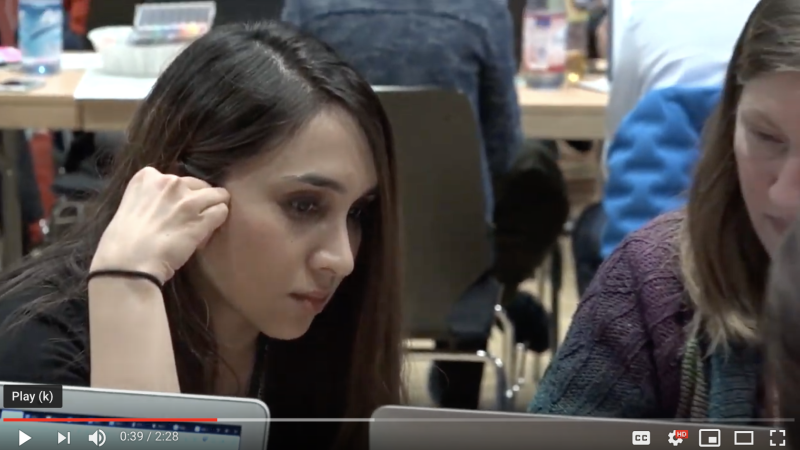Four Design Parameters for Rethinking Professional Learning
If we want to reimagine learning for students, we need to reimagine learning for adults. Given what learning science tells us about how students learn best, by actively engaging in authentic work and doing rather than consuming, it’s puzzling that adult professional learning is still employing the “sage on the stage” model of education. It’s time to reimagine professional learning.
It's time to create professional learning opportunities that actually do what they purport to do: shift educator practice in order to improve student learning outcomes. At its best, professional learning can be networked, collaborative, growth-oriented and focused on what learning science tell us about how humans learn best: through relevant, job-embedded, applied, and experiential learning.
Recently, GOA’s professional learning team traveled to Europe to lead the Rethinking Assessment Summit at Frankfurt International School in collaboration with the Education Collaborative for International Schools (ECIS). During day one, participants learned best practices and practical tools for embedding formative assessment more deeply into their classrooms and schools. On day two, participants took part in a deep dive on the role feedback plays in learning and developed a feedback plan for their students. Participants reviewed numerous case studies from real courses and classrooms on how other teachers utilize formative assessment and design intentional feedback to promote student learning. Participants were given time to apply new content and learning to their own work. At the conclusion of the two-day summit, educators shared their work with colleagues from other institutions in a Presentation of Learning that facilitated the exchange of ideas around formative assessment and feedback.
Rethinking Assessment Summit at Frankfurt International School
Created by Frankfurt International School
What does reimagining professional learning mean? At GOA, we’ve articulated four design parameters for making professional learning work.
Built for School-Based Teams
Unlike other countries that allot 15 to 25 hours weekly for teachers to collaborate with colleagues on preparing and analyzing lessons, U.S. schools only provide 3 to 5 hours a week on average for lesson planning, most of which is done individually. Yet, consider what Finland does well: it sets up strong teams of teachers who look at student work and their own teacher work together. Professional learning should carve out time and space for teachers to collaborate in teams focused on improving teacher practice and creating high quality curriculum. GOA’s latest tool for educators, the Competency-Based Learning Toolkit, is intentionally designed for school-based teams for these reasons.
Personalized Pathways
Linda Darling Hammond speaks to how other countries incorporate job-embedded professional learning that is context-specific and context-relevant to teachers. As you would differentiate for students in the classroom, we should take into account that teachers are arriving at different points in their professional journey and can take ownership over their learning. In our student program, GOA now has professional learning competencies for our GOA faculty, and faculty can demonstrate proficiency in competencies they choose over time.
Time to Work (and get stuff done)
The standard professional development day doesn’t afford time for teachers to actually take what they’ve learned and apply it. PD Days rely on the idea that teachers in good faith will find the time to implement when it suits them. The reality is that without the opportunity to immediately apply what they’ve learned, the knowledge that teachers gain from sit-and-get PD will not get used. They need time to design, collaborate, and give one another feedback. For example, GOA’s premier in person conference, the Learning Design Summit, is intentionally designed to allow educators time to draft, build, and iterate a new lesson, unit, or course based on proven instructional design principles we’ve used to design student courses for the last eight years.
Expert Content and Coaching
For professional learning to have impact, the content needs to be by and for teachers. At GOA we’ve come to recognize the importance of having educators work with an instructional coach who can provide real time feedback and support. Offering coaching as part of a professional learning program can help to sustain professional growth beyond just a day. We’ve seen this in action through our partnership with Garnet Valley School District (PA, USA), where we are training middle and high school teachers in instructional design using a coaching-cohort model.
Recommendations
Consider this from Linda Darling-Hammond: “Research shows that professional learning can have a powerful effect on teacher skills and knowledge, and on how well students learn. To be effective, however, professional learning for teachers needs to conducted in the ways that it is many high achieving countries—continuously, collaboratively, and with a focus on teaching specific content to particular learners.”
- Time. Schools should intentionally schedule time for collaboration so teachers can engage in collective curriculum planning, analysis of student work, and sustained, job-embedded professional learning.
- Relationships. Humans learn in relationships with one another. Professional learning opportunities should be supported by coaching and linked to competencies that students are expected to meet.
- Sustainability. Schools should rethink the full faculty PD day. Consider providing choice-based options, coaching for school-based teams, and smaller workshops for teams. Imagine the PD Day as a launching point for ongoing and sustained professional learning that can move the needle and improve teacher practice in ways “one and done” simply cannot.
- Personalization and pace. Everyone is a learner. Leaders should ensure that professional learning opportunities model the types of learning experiences they want for students. What are the skills, dispositions, and mindsets we want for our educators? Let’s design a system that allows educators to develop these competencies in personalized pathways, at their own pace, in job-embedded ways through relevant learning and applied design, just as we would want for our students.
This blog is part of our Rethinking School Series which seeks to reimagine structure, culture, and pedagogy that fosters deep learning in school. Join us in one of our upcoming Rethinking School one week online courses.


